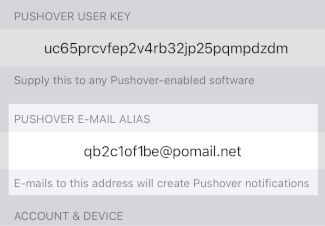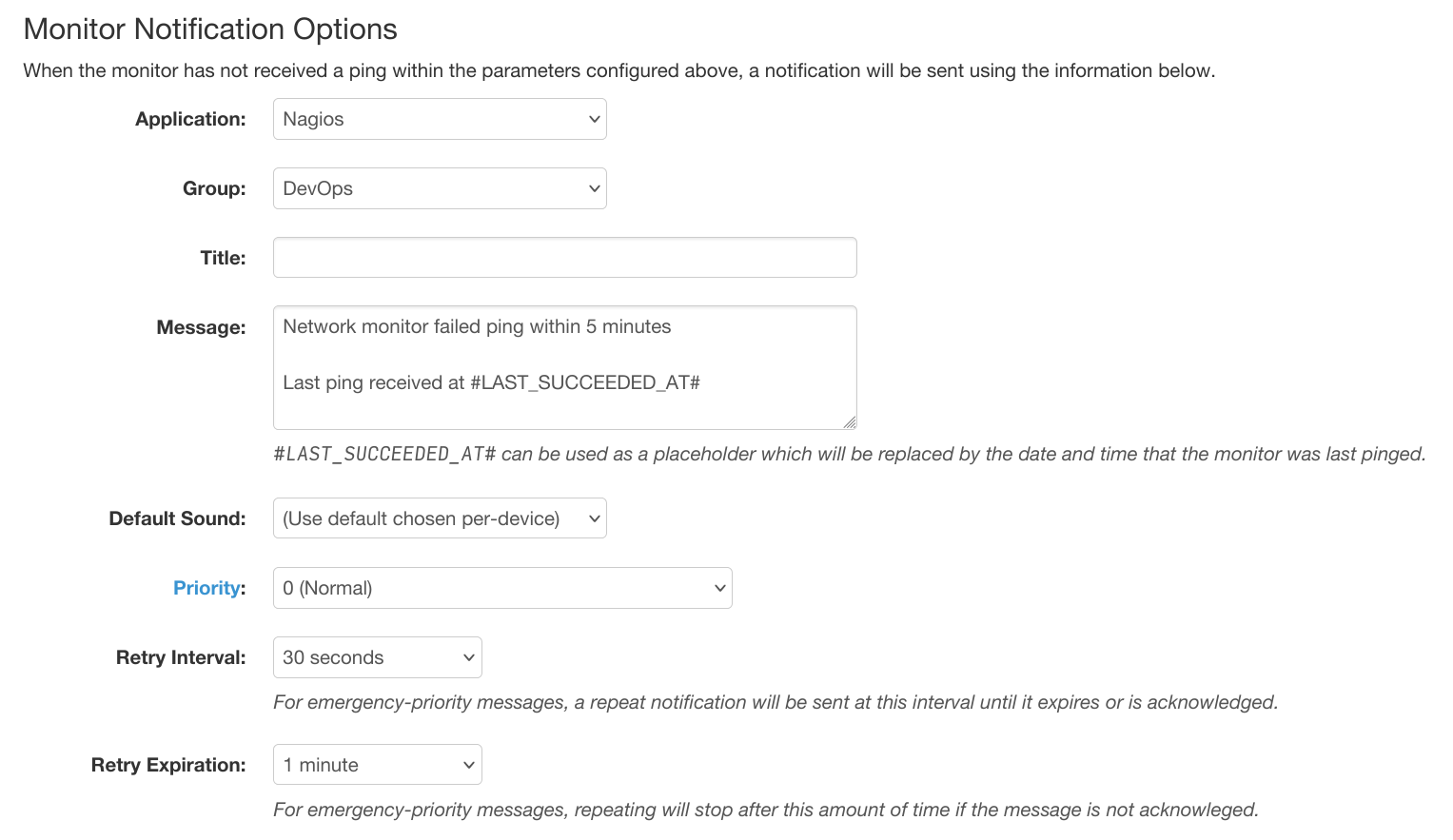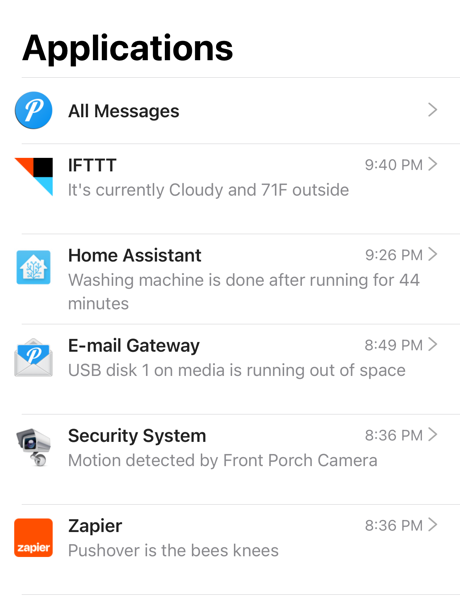Replacing AT&T Email-To-Text With Pushover Notifications

AT&T has announced they are shutting down their email-to-text and text-to-email services on June 17, 2025. If you relied on AT&T’s email-to-text service to send short messages to your phone, here’s how you can easily replace it with push notifications from Pushover.
Setup
To get started, install the Pushover for iPhone and iPad or Pushover for Android app from App Store or Google Play. It’s a free download.
Once the app is installed, enter your e-mail address and a password, then register your device with a name which will come into play later if you have multiple devices (you can always change the name later).
At the main screen of Pushover, tap the settings icon in the upper right corner and you’ll see your new user key and your Pushover e-mail alias. Your unique Pushover e-mail address is all you need to get started receiving Pushover notifications. Tap on it to copy it to the clipboard and any e-mail sent to that address will come through to your phone as a push notification. That’s it!


Pushover for individuals is free to try on all your devices risk-free for 30 days with full functionality. After 30 days, you can purchase a Pushover license for your device with a single one-time $4.99 USD in-app purchase and you’ll be set for life with no subscription. Pushover has been providing push notification services since 2012.
Configuration and Additional E-Mail Addresses
If you want to change settings for your e-mail alias or create additional ones, head over to your Pushover dashboard and click on the new e-mail alias under Your E-Mail Aliases.
You can change settings such as the default sound played on your device when the notification is received, and you can even upload your own sounds.
The message priority can also be changed to -1 to send quiet notifications, 1 to send high priority notifications which can bypass any configured Quiet Hours on your account, or priority 2 which will repeat at the configured interval to really get your attention. You can even configure priority 1 or 2 notifications to bypass your device’s mute switch for really, really important notifications.
Pushover for Teams
If your company or organization relied on AT&T’s email-to-text service to send out alerts to staff members, check out Pushover for Teams which makes it easy to manage multiple Pushover accounts and create additional delivery groups to send to certain groups of staff with a single Pushover e-mail alias.
New Pushover for Teams Feature: Inactivity Monitors
A new frequently requested feature is available today for Pushover for Teams subscribers and included free with your subscription: inactivity monitors.
Inactivity Monitors
Many Pushover users utilize our service for sending alerts from network monitoring systems such as Zabbix, Nagios, and PRTG. When a device or service is unreachable, a Pushover notification can alert operations staff of the problem with customizable delivery options.
But what happens when your network’s internet connection is down and alerts can’t reach us, or the monitoring system itself has failed?
Pushover’s new Inactivity Monitors act as a “heartbeat” mechanism where your monitoring device (or any device) pings our API every so often and when we haven’t received a ping in a configured amount of time, a Pushover notification is sent to your group.
Inactivity Monitors can also be setup for each server or device, avoiding the need to setup a network monitor at all. This is also helpful for networks or internal services that aren’t reachable by an external monitoring service such as Pingdom. Rather than having to monitor each device locally, each of your servers can just ping our API and we’ll notify you when they stop.
Creating a Monitor
Pushover for Teams administrators will now see an option to “Create a Monitor” on their team dashboard.

Teams can create as many monitors as needed, each with their own timeouts and alert settings. The main setting is the inactivity duration, which determines how long we’ll wait to receive a ping since the last one before sending an alert.

Alert Options
When our API has failed to receive a ping at the URL we provide in the configured amount of minutes, we’ll generate a notification to the group you choose with all of the options you’ve configured:

Once an alert is sent for an inactive device, we won’t alert for it again for future missed pings until it pings again.
Inactivity Monitors are available today for all Pushover for Teams subscribers. We hope you find this feature useful and we’ll be introducing additional monitor types in the future. We’d love to hear your feedback and feature suggestions.
Upcoming Discontinuation of SMS Backup Delivery
Later this year, Pushover will be discontinuing our SMS Backup Delivery mechanism for Pushover for Teams subscribers receiving emergency-priority messages.
While only 6% of Pushover for Teams users are utilizing SMS Backup Delivery, we understand that it is an important failsafe for certain users. However, our mobile applications have gained functionality in recent years that makes SMS backup delivery less of a requirement, as we’ll detail below.
Timeline
On April 1, 2024, our website will no longer allow new SMS numbers to be added to Pushover accounts but we will continue delivering to existing SMS numbers until July 1st.
On July 1, 2024, we will stop sending SMS messages altogether and will only retry delivery by push notification. Existing SMS phone numbers on file will be deleted.
Please note that if per-country restrictions detailed below are imposed before these dates, we may have to stop SMS delivery in those countries.
Why is SMS Backup Being Discontinued?
In the six years since Pushover for Teams launched with SMS Backup Delivery, mobile phone providers worldwide have greatly tightened restrictions on SMS delivery to combat spam and fraud. While mostly well-intentioned, these restrictions make it difficult and costly for small businesses like Pushover to send legitimate SMS messages to our customers who have opted into receiving them.
Many countries have also imposed restrictions on leasing local phone numbers (called “long codes”), requiring that we have a local presence in each of these countries where we want to use a local phone number. While not strictly necessary, we have tried to acquire local numbers in many countries where we have users so they don’t have to send a reply SMS to a number in another country which can be expensive.
Mobile phone providers and SMS services like the one we use are pushing companies to purchase “short codes” (5-6 digit numbers) for automated SMS delivery rather than the country-specific “long codes” we are currently using. Unfortunately the cost of acquiring and leasing a short code is extremely expensive and laborious, especially as carriers in each country where we want to deliver messages each impose large monthly fees which would greatly eclipse all of the revenue generated by our Pushover for Teams service as a whole.
Push Notification Enhancements
While SMS Backup Delivery has been useful in increasingly-rare situations where mobile data service is unavailable but mobile phone service is, the most popular use of our SMS Backup has been to bypass a device’s mute switch by creating a contact for our local phone number and setting it to be allowed to play sounds when the device is muted. In recent years, Pushover’s mobile apps for Android and iOS have gained the ability to do this without SMS delivery.
On Android, our app has the ability to play sounds for emergency-priority messages through the device’s alarm channel, just as an alarm clock application does. Our application can also be specifically permitted to bypass Do Not Disturb.
On iPhone and iPad, our application was granted a special entitlement by Apple to generate Critical Alerts which are notifications that bypass the device’s mute switch with a specified volume.
Support
If you have any questions or concerns about the upcoming removal of SMS Backup Delivery, please contact Pushover support.
A Note About Notification Encryption and Privacy
In the news recently is a report that “foreign officials were demanding [push notification] data from Alphabet’s Google and Apple”.
While we have no knowledge of any targeting of push notification data of our customers, we have had some questions about how we deliver push notifications and what data is made available to Google and Apple.
Pushover Notifications are Encrypted
Since 2015, Pushover’s iPhone/iPad and Android apps have supported notification payload encryption, and enforced it for all devices as of 2019. Pushover’s desktop client only communicates directly with Pushover’s servers over TLS, though macOS desktop notifications (registered through Safari) are processed directly by macOS and cannot be encrypted. This is changing for macOS with the recent availability of W3C Web Push in Safari, which can be used now with our web push beta, as it allows some client-side processing of notification data before the operating system displays it.
This encryption for iOS and Android is activated at device registration time by the device generating a secret key and sending it directly to Pushover’s API servers over a standard TLS-encrypted connection. When Pushover’s servers receive a new message for a device, our servers encrypt the title, message body, URL, and all other message metadata with that device’s secret key and send it over a TLS-encrypted connection to Apple’s (APNS) or Google’s (HTTPS) push notification servers. The only data that Apple or Google can see through their push notification servers is an encrypted string, for which they do not have the decryption key.
Once the device receives an encrypted push notification, it is handed off to the Pushover application’s notification handler which then decrypts it using its stored key, and hands it back to the operating system as a notification to display on the screen. This also allows our application to download any image attachments or custom sounds directly from our API, again over a standard TLS-encrypted connection.
If you have ever received a Pushover notification on iOS after restarting your device but before unlocking it, your Pushover notification will have shown “[Could not decrypt notification. Please open the Pushover app to unlock.]” This is because iOS had not yet unlocked access to the application’s settings which include its decryption key, so the notification could not be decrypted.
If you have any further questions about Pushover’s security or privacy, please feel free to contact us.
Pushover 4.0: Expiring Messages, New Apps View, Supporting Development
Pushover 4.0 for Android, iOS, and Desktop is out now and adds a new look and support for a new message expiration function.
New Apps View

When swiping right on the message list to show the list of applications that have sent messages, the list is now sorted by the latest sender, and under each source is a snippet of the latest message.
This view is inspired by the Messages application on iOS and makes it easier to see the newest message from each application rather than having to scroll through the list of All Messages.
On iOS, our application and message lists now use the updated header style introduced in iOS 11 but took… a while to get used to.
Expiring Messages
A new feature supported by our API and our new apps is Expiring Messages.
Setting the Time To Live (ttl parameter) on a message sent to our API sets the
maximum lifetime of the message in seconds.
After that many seconds have passed since the message is received by our API,
the message will automatically delete from the devices it was sent to.
On Android and Desktop, notifications from these messages will automatically
expire and remove themselves from the notification center.
Unfortunately due to limitations on iOS, notifications can only expire once another notification has been received (or when the Pushover app is opened), since that is the only opportunity our app extension gets to clean up expired notifications. We’ve applied for a special entitlement from Apple to support this but have not yet been approved.
On all platforms, expired messages delete from the message list automatically. This makes it a handy feature for unimportant messages that are only useful for a short timeframe, such as notifications about open doors from a security system.
Support Development
And finally, our iOS and Android apps now also support directly supporting Pushover development with optional in-app purchases. For over ten years, purchasing a lifetime of Pushover notifications has remained a single one-time in-app purchase for individuals with no monthly or yearly costs.
Many users having paid once many years ago still rely on Pushover every day and have asked for a way to “re-up” their purchase and contribute to Pushover’s continued development. Our iOS and Android apps now have a screen in the settings menu that enables in-app purchases beyond the initial one-time license purchase. These tips are of course completely optional but greatly appreciated and go toward Pushover’s monthly server costs and continued development.